CROATIA
Pula

Pula
Pula
Pula is one of the most famous historical cities in Croatia. The biggest crowd puller of this city is without a doubt the impressive amphitheater. Pula belonged to Italy until 1947 and therefore has many Venetian influences. Pula is located by the sea on the southern part of the Istria peninsula. This makes Pula a good destination for those looking for a combination of a city trip and a sun holiday.
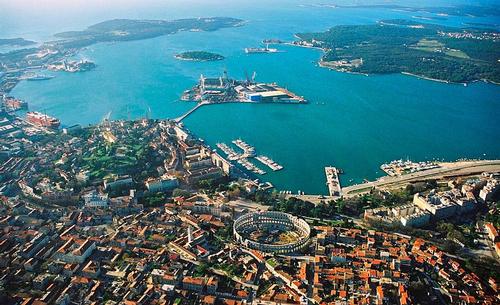 PulaPhoto: Orlovic CC 3.0 Unported no changes made
PulaPhoto: Orlovic CC 3.0 Unported no changes made
Location
Pula is located in the westernmost county of Croatia: Istria. Pula is located on the Adriatic Sea in the south of the Istrian peninsula. The city is built on seven hills and covers an area of 51.6 square meters. With more than 60,000 inhabitants, Pula is the seventh largest city in Croatia.
Weather
Pula has a Mediterranean climate. The peninsula enjoys protection from the Alps in the north and the Adriatic Sea moderates the temperatures. Summers are warm in Pula with an average temperature of 24 degrees. In winter, the mercury rarely drops below 5 degrees. Temperatures in Pula are also very pleasant in spring and autumn.
The wind is a constant topic of conversation in Istria and Pula. In winter, the Bora brings fresh air from the north. The Bora is usually very powerful and therefore very much feared by the inhabitants of Pula. The Jugo is a southerly wind that sometimes carries rain in the summer and the Mistral brings air from the interior to the sea. There is a lot of talk about the wind, but extreme weather conditions are hardly ever seen in Pula.
History
Near Pula a stone ax has been found in a cave that is said to be more than 80,000 years old. This makes Pula the oldest city on the East Adriatic coast. The name Pula comes from Roman times and means castle. Istria owes its name to the Histrians who held sway in Pula until 177 BC. Then the Romans conquered the city and built, among other things, the beautiful Amphitheater. Pula grew rapidly under the leadership of Emperor Augustus. The city expanded in circular stages and eventually came to lie on seven hills.
The history of Pula is characterized by different domination. For example, the city, like many other parts of Istria, fell under Venetian rule from 1331. During the Congress of Vienna, the city was allotted to Austria.
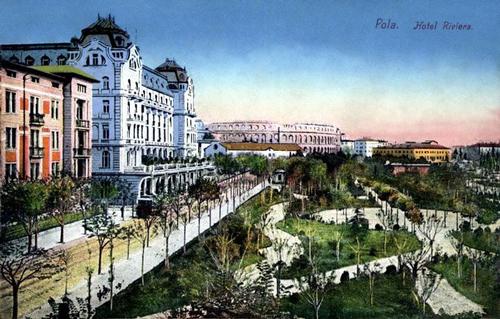 Hotel Riviera in Pula around 1900Photo: Public Domain
Hotel Riviera in Pula around 1900Photo: Public Domain
When Austria-Hungary fell apart in 1918, Italy ruled Istria. Pula was renamed Pola. Only in 1947 did the city officially belong to Yugoslavia. In 1991 the whole of Croatia, including Pula, became completely independent.
Sights
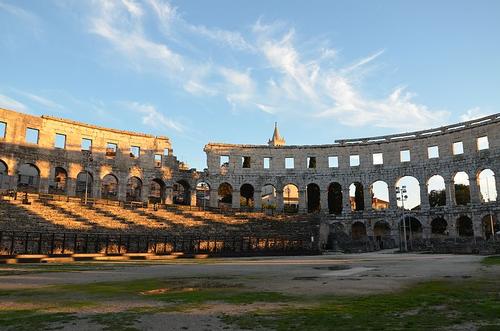 Pula AmphitheaterPhoto: Marcus Cyron CC 2.0 Generic no changes made
Pula AmphitheaterPhoto: Marcus Cyron CC 2.0 Generic no changes made
The number one landmark is the amphitheater. It was built in the first century and is amazingly well preserved. The amphitheater is still the stage for festivals, operas and concerts today and films are regularly shown. It seats 23,000 spectators and shows just how good the Romans were at designing amphitheaters. Under the Amphitheater of Pula you can visit an exhibition that shows how the Romans already made olive oil and wine in their time. There are olive and grape presses. There are also hundreds of amphorae found during excavations at and around the theater.
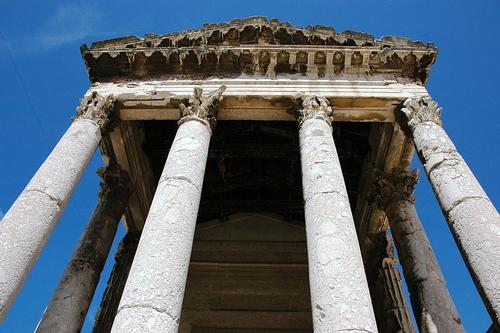 Pula August TemplePhoto: Josep Renalias CC 3.0 Unported no changes made
Pula August TemplePhoto: Josep Renalias CC 3.0 Unported no changes made
The temple of Augustus is also worth a visit. The temple was built under the direction of Augustus and he very modestly dedicated the sanctuary to himself. The temple consists of six columns. Under Byzantine rule, the temple was renamed a church. Next to the Augustus temple is the Gradska Palaca, or the town hall, which was built in 1296. In order not to collapse, this beautiful building must be held together with steel cables.
 Mosaic of the blessed virginin in the cathedral of PulaPhoto: Georges Jansoone CC 4.0 no changes made
Mosaic of the blessed virginin in the cathedral of PulaPhoto: Georges Jansoone CC 4.0 no changes made
Pula Cathedral was built in 1640 on top of ruins of earlier structures. Fragments of mosaics from the 5th and 6th centuries can be discovered in the floor and the altar is a Roman sarcophagus from the 2nd century. Pula has a historical and an archaeological museum, the latter is especially interesting. It has a collection of special stones from prehistoric and Roman times.
Tips
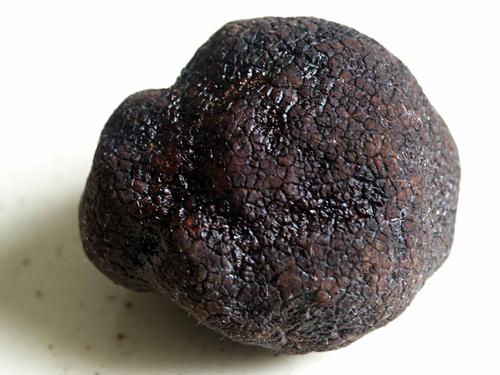 Black Truffles a treat in PulaPhoto: Public Domain
Black Truffles a treat in PulaPhoto: Public Domain
Both black and white truffles are found in the forests of Istria. If you want to treat yourself, it is absolutely advisable to eat a dish with truffles. Many restaurants have fûzi, a type of pasta, with truffle on the menu. Drink a glass of white or red Croatian wine, which is in no way inferior to the Italian wines.
In addition to good food, you can also find a beautiful underwater world in the seawater of the coast of Pula. With a snorkel you can see the most beautiful fish, crabs and other sea creatures. It is advisable to put on water shoes, because the Istrian beaches are rocky and you will hardly find sand anywhere.
Useful links Pula
BBC Country ProfilesWorld Fact Book Explore all Countries
How to call
Last updated November 2025
Copyright: Team - The World of Info